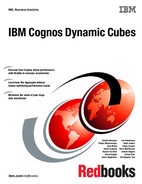4 IBM Cognos Dynamic Cubes
1.1.2 Enterprise data warehouses for analytics
Data warehouses are the recognized foundation for enterprise analytics. They enable an
organization to bring together cleansed data from separate sources of input, both internal and
external, such as from partners or suppliers. Instead of
garbage in, garbage out information
to support decision-making, a consistent and consolidated enterprise-wide view of data from
a business provides the foundation to improve your business. Building upon a trusted
information platform for analytics is a key contributor to long-term business health. Not only
do data warehouses enable higher quality information, they are designed to enable
high-performance data access for analytic style applications.
Cognos Dynamic Cubes technology helps to leverage the core strengths of an EDW and take
the EDW to the next level of performance for analytics, while making the deploying and tuning
easier and faster.
1.1.3 Data volumes and context in the Enterprise Data Warehouse
With social data generating petabytes per day, and instrumented devices becoming the norm,
data volume growth is accelerating at an unprecedented pace.
Big data is a growing business trend, with data from unconventional sources having the
potential to be business disrupters. However, before the power of these new sources can be
fully used, we must understand what is happening within our own business. Understanding
your own business is added value of a data warehouse, and why taking full advantage of
these data holdings is a critical first step to using these new sources of data.
In addition, any organization that relies on instrumented infrastructures has an opportunity to
maximize the efficiency of its operations. Analytics is key to accomplishing this type of
optimization, leading to concrete business results.
With data volumes exploding, and growing urgency to make sense of this sea of data, using a
data warehouse technology, and maintaining a connection to the data warehouse from your
analysis tools helps to rationalize investments.
Easy visibility into enterprise data is a critical step on the journey to insight from various
sources, traditional and emerging. Semi-structured or unstructured data will only make sense
within the context of your business. Your data warehouse contains this context.
1.1.4 Architecture summary
The Cognos Dynamic Cubes technology is part of the IBM Cognos BI query stack, and is
available with existing IBM Cognos entitlements. It provides a new and powerful tool to enable
high performance analytics over large data warehouses.
Cognos Dynamic Cubes solution consists of a modeling tool (IBM Cognos Cube Designer), a
dynamic cube object in the administration environment, which becomes the data source, and
a wizard (Aggregate Advisor), launched from Dynamic Query Analyzer:
? IBM Cognos Cube Designer
Cognos Cube Designer is a modeling tool that brings together best modeling principles
from past successful modeling technology, with a modern and extensible architecture. The
first step to deploying Cognos Dynamic Cubes is to model with the Cognos Cube
Designer.
Chapter 1. Overview of Cognos Dynamic Cubes 5
? IBM Cognos Dynamic Cubes Server
After a dynamic cube is designed and deployed, it becomes available in the Cognos
environment and acts as the data source to the interface layer for dynamic cube
applications. It manages all aspects of data retrieval, and leverages memory to maximize
responsiveness while giving you full flexibility to manage what is contained in memory and
when you want to refresh in-memory data. You manage dynamic cubes in the Cognos
administration environment.
A dynamic cube contains a number of in-memory elements to drive performance:
– Metadata members
When you start a cube, all members are loaded in memory. This approach assures a
fast experience as users explore the metadata tree. This approach also helps the
server to maximize its ability to run the most efficient queries possible.
–Aggregates
With Cognos Dynamic Cubes, you have the option to create in-memory aggregates.
This way allows summaries or aggregates to be returned immediately when users
navigate down from top-level summaries, such as sales per country, and start to drill
down to lower levels, such as states. Each level requires a new total to be returned.
When these totals or other aggregates are loaded in memory, they are returned
instantly.
–Data
When users run the system and run queries, individual data items are loaded in
memory. Because security is applied on top of the dynamic cube, the reuse of data is
maximized, allowing as many users and reports as possible to benefit from previous
queries.
– Results sets
When a report is run, it is saved in memory for later reuse. For commonly used reports,
this way allows the engine to benefit from previous runs, giving users the fastest
response time possible.
– Expressions
To accelerate query planning, the engine saves expressions that are generated when
queries are run. In this way, query planning can be accelerated for future queries when
expressions can be reused.
With in-memory assets that can include aggregates, expressions, results, and data,
Cognos Dynamic Cubes technology provides the tools to minimize user wait-times,
ensuring the best possible user experience.
? Aggregate Advisor (part of IBM Cognos Dynamic Query Analyzer)
After a dynamic cube is deployed in the environment, it becomes available for reporting
and analysis. The server maintains logs to understand how the system is being used, and
can use these logs to help optimize aggregates, both in-memory and in-database.
To create aggregates, you use the Aggregate Advisor, launched from Dynamic Query
Analyzer (DQA), which is a diagnostic tool to help you better understand performance for
Dynamic Query and Cognos Dynamic Cubes. The Aggregate Advisor scans cube
definitions and usage logs, and recommends aggregates to improve performance. This
approach helps to more easily address specific performance problems.
..................Content has been hidden....................
You can't read the all page of ebook, please click here login for view all page.
